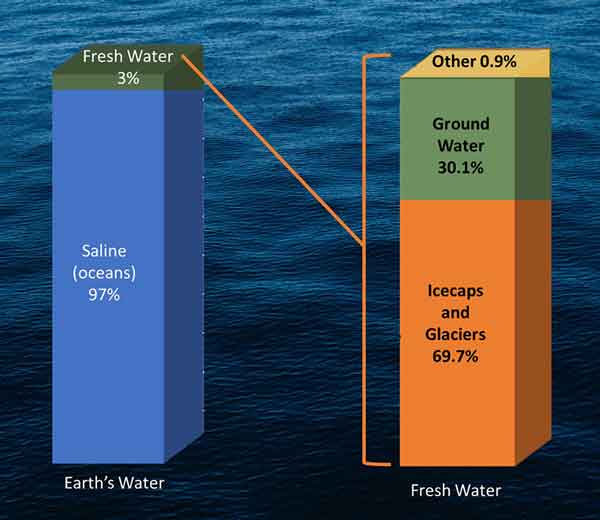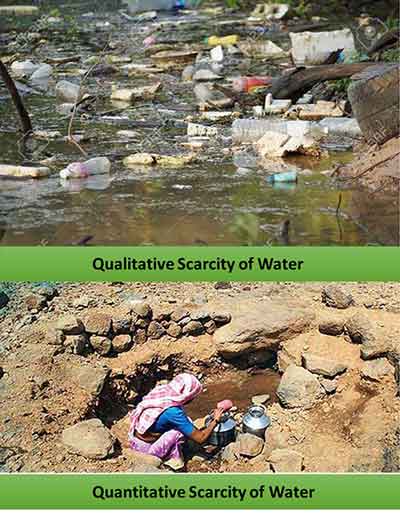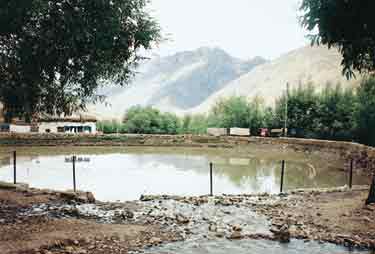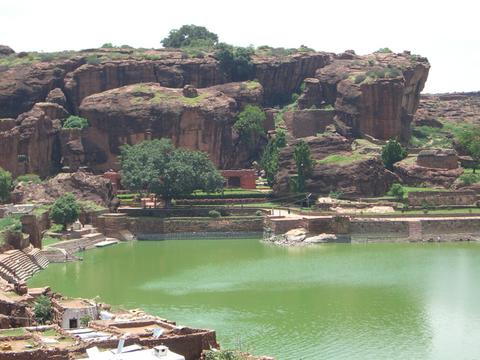
Water Renews itself by Hydrological Process.
This process involves evaporation, condensation and precipitation.
Availability and Scarcity of Water
- ¾ of the Earth is covered with water.
- 2 billion people will face acute water Scarcity by 2025
- Most part of India will also face severe water scarcity
- There can be two types of Water Scarcity – Quantitative Scarcity and Qualitative Scarcity
- Quantitative Scarcity means not availability of water
- Qualitative Scarcity means available water is not potable.
- The following are the causes of water scarcity in the World.
- Only 2.5% of all water available is Fresh Water
- Out of this 2.5 %, 70% is in the form of ice in the poles and in the form of glaciers.
- A little less than 30% is stored in the ground water in the world’s aquifers.
Causes of Quantitative Water Scarcity in India – Natural Causes
- India is the 7th largest country with a geographic area of 3.28 Million Sq. Km.
- It’s share in the world’s population is 17%
- But it’s share in world’s precipitation is mere 4%
- Uneven distribution of rainfall over space and time is one more natural reason
Human factors responsible for Quantitative Scarcity of Water
- Unequal Access among different social groups: Not all social groups have equal access to water resources. The rich and the upper-class people have easy access to water resources while the others are deprived of it.
- Large and Growing Population: A place may have ample water resource. It faces water scarcity eventually, if the population in that region increase beyond a certain limit. This is the case with most of the Indian cities.
- Intensive Agriculture: The growing population needs water directly for its consumption. The agricultural sector should meet the food crop demand of this growing population. The farmers take up intensive cultivation where large amount of water is necessary. It has resulted in depletion of ground water resources all over the country.
- Industrialisation: After globalisation, many MNCs have set up their industries in India. These industries require water directly and indirectly. They need water as raw material, cooling agent and to keep the industrial complex clean. The industries require continuous power supply. 22% of all electricity produced in India comes from Hydro Electric power stations.
- Urban Lifestyle: Large and populous urban centres have contributed heavily to depletion of water resources. The reckless use of water by many in urban centres has only aggravated the situation.
Hydraulic Structures in Ancient India
- In the first century B.C., Sringaverapura near Allahabad had sophisticated water harvesting system channelling the flood water of the river Ganga.
- During the time of Chandragupta Maurya, dams, lakes and irrigation systems were extensively built.
- Evidences of sophisticated irrigation works have also been found in Kalinga, (Orissa), Nagarjunakonda (Andhra Pradesh), Bennur (Karnataka), Kolhapur (Maharashtra), etc.
- In the 11th Century, Bhopal Lake, one of the largest artificial lakes of its time was built.
- In the 14th Century, the tank in Hauz Khas, Delhi was constructed by Iltutmish for supplying water to Siri Fort area.
Multi-purpose River Valley Projects
Advantages – Why did Nehru call the Modern Dams as ‘Temples of Modern India’?
- Many purposes are integrated into one Modern Dam. Hence the name Multipurpose River Valley Project.
- These Multi-Purpose River Valley Projects serve many purposes.
- Irrigation, generation of electricity, supplying water for domestic and industrial use, inland navigation, afforestation, recreation are some of them.
- The dams would integrate development of agriculture and the village economy with rapid industrialisation and growth of the urban economy
- Disadvantages of Dams
- In recent years, multi-purpose projects and large dams have come under great scrutiny and opposition for a variety of reasons.
- The following are those reasons
- Regulating and damming of rivers affect their natural flow.
- This results in excessive sedimentation in the reservoir bed and rockier bed.
- This also results in reduced sedimentation flow in the downstream.
- These conditions are not favourable for aquatic life.
- Dams also fragment rivers. Aquatic life can’t migrate upstream for spawning.
- Dams constructed in flood plains submerges vegetation that leads to decomposition over a time.
- Multi-purpose projects and large dams have also been the cause of many new social movements like the ‘Narmada Bachao Andolan’ and the ‘Tehri Dam Andolan’ etc.
- Local people and the tribal people are always asked to sacrifice their resources, culture, tradition and livelihood for the construction of dams.
- Large farmers, industrialists and urban centres are benefitted but not the people who sacrifice for the construction of dams.
- Irrigation has also changed the cropping pattern of many regions with farmers shifting to water intensive and commercial crops.
- This has great ecological consequences like salinisation of the soil.
- It has transformed the social landscape i.e. increasing the social gap between the richer landowners and the landless poor.
- Social conflicts can also be the result of dams.
- In Gujarat, the Sabarmati-basin farmers were agitated and almost caused a riot over the higher priority given to water supply in urban areas, particularly during droughts.
- Inter-state water disputes are also becoming common regarding sharing the costs and benefits of the multi-purpose project.
- The dams that were constructed to control floods have triggered floods due to sedimentation in the reservoir.
- The multi-purpose projects can induce earthquakes, cause waterborne diseases and pests and pollution resulting from excessive use of water.
Traditional ways of Rainwater Harvesting
In hill and mountainous regions, people-built diversion channels like the ‘guls’ or ‘kuls’ of the Western Himalayas for agriculture. Water from the hills transported through these diversion channels and stored in circular ponds for later use.
In arid and semi-arid regions, agricultural fields were converted into rain fed storage structures that allowed the water to stand and moisten the soil like the ‘khadins’ in Jaisalmer and ‘Johads’ in other parts of Rajasthan.
In the flood plains of Bengal, people developed Inundation Channels to irrigate their fields.
- In arid and semi-arid regions, agricultural fields were converted into rain fed storage structures that allowed the water to stand and moisten the soil like the ‘khadins’ in Jaisalmer and ‘Johads’ in other parts of Rajasthan.
- ‘Rooftop rain water harvesting’ was commonly practised to store drinking water, particularly in Rajasthan.
- In the semi-arid and arid regions of Rajasthan, particularly in Bikaner, Phalodi and Barmer, almost all the houses traditionally had underground tanks or tankas for storing drinking water.
- The tankas were part of the well-developed rooftop rainwater harvesting system and were built inside the main house or the courtyard.
- They were connected to the sloping roofs of the houses through a pipe.
- Rain falling on the rooftops would travel down the pipe and was stored in these underground ‘tankas’.
The first spell of rain was usually not collected as this would clean the roofs and the pipes. The rainwater from the subsequent showers was then collected
One mark Questions
1 Mark Questions
- What is Quantitative Scarcity of Water?
- What is Qualitative Scarcity of Water?
- What are Multi-Purpose River Valley Projects?
- Who has called Dams as ‘The Temples of Modern India’?
- Name the region where farmers rose in riot over higher priority given to urban centres for water supply.
- What are the objective of the Bhakra-Nangal Project?
- What are the main objectives of the Hirakud Project?
- Who is the leader of Narmada Bachao Movement?
- Give any two examples of Inter-State water sharing dispute.
- What is Rainwater Harvesting?
- What are ‘Kuls’ and ‘Guls’?
- What are ‘Khadins’ and ‘Johads’? Where do you find them?
- What are Tankas?
- What is Palar Pani?
- Name the village in Karnataka where most houses have Roof Top Rainwater Harvesting system.
- Name the state that made Roof Top Rainwater Harvesting compulsory for the first time.
- In which state do you find Bamboo Drip Irrigation System?
- What are Inundation Channels?
- Mention any two advantages of Dams.
- Mention any two disadvantages of Dams.
Three mark Questions
3 Mark Questions
- What are the natural causes of Water Scarcity?
- Industrialisation is one of the major causes of depletion of Water Resources. Substantiate.
- Why did Nehru call Dams as the ‘Temples of Modern India’?
- What are the main causes of Qualitative Scarcity of water?
- Mention any three disadvantages of Multi-Purpose River Valley Projects.
- Explain the traditional ways of Rainwater Harvesting.
- Explain the Roof Top Rainwater Harvesting practiced in Rajasthan.
Five Mark Questions
5 Mark Questions
- Explain the various causes of depletion of Water Resources.
- What are the advantages of Multi-Purpose River Valley Projects?
- Multi-purpose projects and large dams have come under great scrutiny and opposition for a variety of reasons. Explain them.
- Discuss the various traditional ways of Rainwater Harvesting practiced in different parts of India







